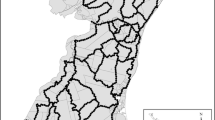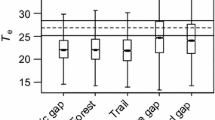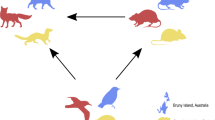Abstract
Areas of high conservation value are often baited with poison to reduce the density of invasive predators, and consequentially reduce the impact on native animals. Poison baits are typically distributed uniformly across a landscape, but there has been no work to determine if this is a cost-effective way to protect endangered species. We consider a small, high-value conservation asset within a broader landscape that is baited to control invasive predators. The predator density in the baited region is modelled with a reaction-diffusion equation, and we use optimal control theory to solve for the long term baiting strategy which minimises the predator density at the conservation asset.







Similar content being viewed by others
References
Algar D, Burrows ND (2004) Feral cat conrol research: Western Shield review—February 2003. Conserv Sci West Aust 5(2):131
Balogh S, Gentle M, Brown S (2001) In: Proceedings 12th Australasian vertebrate pest control conference, Department of Natural Resources and Environment, Melbourne, Victoria
Bode M, Burrage K, Possingham HP (2008) Using complex network metrics to predict the persistence of metapopulations with asymmetric connectivity patterns. Ecol Model 214(2–4):201. doi:10.1016/j.ecolmodel.2008.02.040
Bode M, Wintle B (2010) How to build an efficient conservation fence. Conserv Biol 24(1):182–188. doi:10.1111/j.1523-1739.2009.01291.x
Canada A, Gamez JL, Montero JA (1998) Study of an optimal control problem for diffusive nonlinear elliptic equations of logistic type. SIAM J Control Optim 36(4):1171
Cantrell S, Cosner C, Ruan S (2010) Spatial ecology. Chapman and Hall/CRC
Carrasco LR, Baker R, MacLeod A, Knight JD, Mumford JD (2010) Optimal and robust control of invasive alien species spreading in homogeneous landscapes. J Royal Soc Interface 7(44):529. doi:10.1098/rsif.2009.0266
Carritt R (1999) Fox control in wildlife habitat. In: Technical Report, NSW National Parks and Wildlife Service, Sydney
Carter A, Luck GW, McDonald SP (2011) Fox-baiting in agricultural landscapes in south-eastern Australia: a case-study appraisal and suggestions for improvement. Ecol Manag Restor 12(3):214–223. doi:10.1111/j.1442-8903.2011.00604.x
Chisholm RA, Taylor R (2010) Body size and extinction risk in Australian mammals: an information-theoretic approach. Aust Ecol 35(6):616–623. doi:10.1111/j.1442-9993.2009.02065.x
Clark CW, Munro GR (1975) The economics of fishing and modern capital theory: a simplified approach. J Environ Econ Manag 2(2):92. doi:10.1016/0095-0696(75)90002-9
Clobert J, Le Galliard JF, Cote J, Meylan S, Massot M (2009) Informed dispersal, heterogeneity in animal dispersal syndromes and the dynamics of spatially structured populations. Ecol Lett 12(3):197–209. doi:10.1111/j.1461-0248.2008.01267.x
Cohen H (2007) In: complex analysis with applications in science and engineering. Springer, US, pp 249–366
Coleman J (1995) Department of conservation, p 11
Coman B, Staples LS, McPhee SR, Walker A (1995) In: 10th Australian vertebrate pest conference proceedings: Department of Primary Industry and Fisheries, Tasmania, Hobart, Tasmania, pp 234–237
Connolly T, Day T, King C (2009) Estimating the potential for reinvasion by mammalian pests through pest-exclusion fencing. Wildl Res 36(5):410
Courchamp F, Chapuis JL, Pascal M (2003) Mammal invaders on islands: impact, control and control impact. Biol Rev 78(3):347–383. doi:10.1017/S1464793102006061
de Preu N (2000) Operation bounceback interim report. In: Technical report, Department for Environment and Heritage, South Australia
Denny E, Dickman CR (2010) Review of cat ecology and management strategies in Australia. In: Technical report, Invasive Animals Cooperative Research Centre
Driscoll TA, Trefethen LN (2002) Schwarz–Christoffel mapping, 1st edn. Cambridge University Press
Ecosystems and human well-being (2005) Biodiversity synthesis. In: Technical report, World Resources Institute, Washington, DC
Hauser CE, McCarthy MA (2009) Streamlining ‘search and destroy’: cost-effective surveillance for invasive species management. Ecol Lett 12(7):683–692. doi:10.1111/j.1461-0248.2009.01323.x
Hayward MW, Kerley GI (2009) Fencing for conservation: restriction of evolutionary potential or a riposte to threatening processes?. Biol Conserv 142(1):1. doi:10.1016/j.biocon.2008.09.022
Holmes EE (1993) Are diffusion models too simple? A comparison with telegraph models of invasion. Am Nat 142(5):779. doi:10.2307/2462716
Hone J (1990) Predator-prey theory and feral pig control, with emphasis on evaluation of shooting from a helicopter. Aust Wildl Res 17(2):123–130
Jordan BW, Polak E (1964) Optimal control of aperiodic discrete-time systems. J Soc Ind Appl Math Ser A Control 2(3):332–346
Kot M (2001) Elements of mathematical ecology. Cambridge University Press
Lenhart S, Protopopescu V, Stojanovic S (1993) A minimax problem for semilinear nonlocal competitive systems. Appl Math Optim 28(2):113. doi:10.1007/BF01182976
Lenhart S, Workman JT (2007) Optimal control applied to biological models. In: Mathematical and computational biology series, Chapman & Hall/CRC, London
Leung A, Stojanovic S (1993) Optimal control for elliptic Volterra-Lotka type equations. J Math Anal Appl 173(2):603. doi:10.1006/jmaa.1993.1091
Matthysen E (2005) Density-dependent dispersal in birds and mammals. Ecography 28(3):403–416. doi:10.1111/j.0906-7590.2005.04073.x
McLennan JA, Potter MA, Robertson HA, Wake GC, Colbourne R, Dew L, Joyce L, McCann AJ, Miles J, Miller PJ, Reid J (1996) Role of predatation in the decline of kiwi, Apteryx spp., in New Zealand. N Z J Ecol 20(1):27
Miller Neilan R, Lenhart S (2011) Optimal vaccine distribution in a spatiotemporal epidemic model with an application to rabies and raccoons. J Math Anal Appl 378(2):603. doi:10.1016/j.jmaa.2010.12.035
Moore JL, Rout TM, Hauser CE, Moro D, Jones M, Wilcox C, Possingham HP (2010) Protecting islands from pest invasion: optimal allocation of biosecurity resources between quarantine and surveillance. Biol Conserv 143(5):1068. doi:10.1016/j.biocon.2010.01.019
Murdoch W, Polasky S, Wilson KA, Possingham HP, Kareiva P, Shaw R (2007) Maximizing return on investment in conservation. Biol Conserv 139(3–4):375. doi:10.1016/j.biocon.2007.07.011
Murray AJ, Poore RN, Dexter N (2006) Project deliverance the response of critical-weight-range mammals to effective fox control in mesic forest habitats in far east gippsland. In: Technical report, Department of Sustainability and Environment, Victoria, Melbourne
Murray JD, Stanley EA, Brown DL (1986) On the spatial spread of Rabies among foxes. Proc Royal Soc Lond Ser B Biol Sci 229(1255):111. doi:10.1098/rspb1986.0078
Murray R, Poore R (2001) In: Proceedings: Australian Wildlife Management Society, 14th annual conference. NSW National Parks and Wildlife Service, Dubbo
Neubert MG (2003) Marine reserves and optimal harvesting. Ecol Lett 6(9):843–849. doi:10.1046/j.1461-0248.2003.00493.x
Neubert MG, Herrera GE (2008) Triple benefits from spatial resource management. Theor Ecol 1(1):5. doi:10.1007/s12080-007-0009-6
Papamichael N, Stylianopoulos N (2010) Numerical conformal mapping. World Scientific, Singapore
Pollard A (2000) In: Proceedings of the NSW pest animal control conference. NSW Agriculture, Orange, New South Wales
Pontryagin LS (1987) In: Pontryagin LS(ed) Mathematical theory of optimal processes, english edn. CRC Press
Possingham H, Jarman P, Kearns A (2004) Independent review of Western Shield-February 2003. Conserv Sci West Aust 5(2):2
Priddel D, Wheeler R (1997) Efficacy of fox control in reducing the mortality of released captive-reared Malleefowl, Leipoa ocellata. Wildl Res 24(4):469
Pulliam HR (1988) Sources, sinks, and population regulation. Am Nat 132(5):652
Richards J, Short J (2003) Reintroduction and establishment of the western barred bandicoot Perameles bougainville (Marsupialia: Peramelidae) at Shark Bay, Western Australia. Biol Conserv 109(2):181. doi:10.1016/S0006-3207(02)00140-4
Roa AV (2009) A survey of numerical methods for optimal control. Adv Astronaut Sci 135(1):497
Roache PJ (1972) On artificial viscosity. J Comput Phys 10(2):169. doi:10.1016/0021-9991(72)90058-7
Robley A (2011) Review of fox control measures in box ironbark conservation management networks. In: Technical report 221, Arthur Rylah Institute for, Environmental Research, Wedderburn
Robley A, Wright J, Gormley A, Evans I (2008) Adaptive experimental management of foxes. Final report, Technical Report 59, Parks Victoria, Melbourne
Rout TM, Kirkwood R, Sutherland D, Murphy S, McCarthy M (2013) When to declare successful eradication of an invasive predator? Anim Conserv. doi:10.1111/acv.12065
Rout TM, Hauser CE, Possingham HP (2009) Optimal adaptive management for the translocation of a threatened species. Ecol Appl 19(2):515. doi:10.1890/07-1989.1
Salinas RA, Lenhart S, Gross LJ (2005) Control of a metapopulation harvesting model for black bears. Nat Resour Model 18(3):307–321. doi:10.1111/j.1939-7445.2005.tb00160.x
Saunders G, McLeod L (2007) Improving fox management strategies in Australia. Bureau of Rural Sciences, Canberra, Australia
Symm DGT (1969) Numerische Mathematik. Numerische Mathematik 13(5):448. doi:10.1007/BF02163272
Thomson PC, Algar D (2000) The uptake of dried meat baits by foxes and investigations of baiting rates in Western Australia. Wildl Res 27(5):451
Thompson JF, Thames FC, Mastin C (1974) Automatic numerical generation of body-fitted curvilinear coordinate system for field containing any number of arbitrary two-dimensional bodies. J Comput Phys 15(3):299. doi:10.1016/0021-9991(74)90114-4
Tores PJd, Marlow N (2012) In: Somers MJ, Hayward M (eds) Fencing for conservation. Springer, New York, pp 21–42
Victorian Department of Sustainability, Environment (2003) Southern Ark project: benefiting the biodiversity of East Gippsland through fox control. In: Department of Sustainability and Environment, Melbourne
Wayne A (2008) Diagnosis of recent woylie (bettongia penicillata ogilbyi) declines in southwestern Australia. In: Progress report, Woylie conservation research project
Wiens JA (2001) In: Clobert J, Danchin E, Dhondt AA, Nicholas JD (eds) Dispersal. Oxford University Press, USA
Acknowledgments
The authors would like to thank Steve Carnie and Tamsin Lee for their assistance.
Author information
Authors and Affiliations
Corresponding author
Additional information
This research was funded by the Australian Government’s National Environmental Research Program, the ARC Centre of Excellence for Environmental Decisions and an ARC DECRA (DE130100572)
Rights and permissions
About this article
Cite this article
Baker, C.M., Bode, M. Spatial control of invasive species in conservation landscapes. Comput Manag Sci 10, 331–351 (2013). https://doi.org/10.1007/s10287-013-0196-0
Received:
Accepted:
Published:
Issue Date:
DOI: https://doi.org/10.1007/s10287-013-0196-0
Keywords
- Optimal control
- Pontryagin
- Bait distribution
- Invasive predators
- Conformal transformation
- Exclusion fencing




